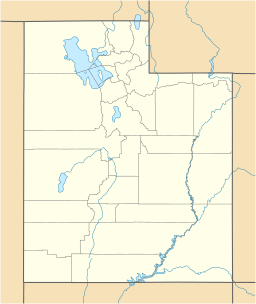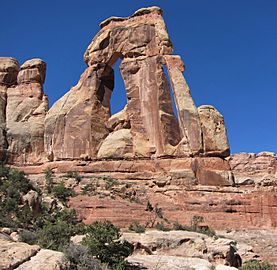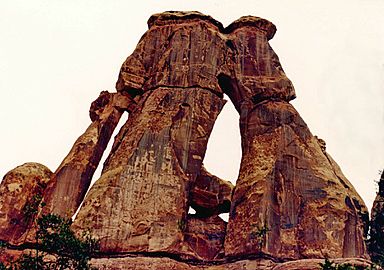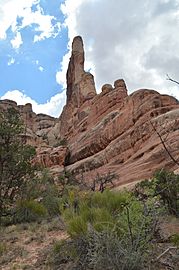Druid Arch facts for kids
Quick facts for kids Druid Arch |
|
|---|---|

Druid Arch, east aspect
|
|
| Highest point | |
| Elevation | 5,653 ft (1,723 m) |
| Geography | |
| Location | Canyonlands National Park San Juan County, Utah, U.S. |
| Topo map | USGS Druid Arch |
| Geology | |
| Age of rock | Permian |
| Type of rock | Cedar Mesa Sandstone |
Druid Arch is a huge natural rock arch, about 150 feet tall. You can find it in the Needles District of Canyonlands National Park in Utah. It sits at the top of Elephant Canyon. Rainwater from the arch flows into Elephant Canyon and then into the nearby Colorado River.
Many people love to hike to Druid Arch, making it a very popular spot. The hike to the arch is about 5.4 miles long. It starts at the Elephant Hill Trailhead. The last part of the trail is quite steep, and you might need to climb a bit or use a ladder. Its name comes from Stonehenge in England. Stonehenge is a famous ancient stone monument that looks a bit like Druid Arch. People once thought Stonehenge was a temple built by ancient priests called Druids. The name "Druid Arch" was officially accepted in 1963.
What is Druid Arch?
This amazing rock formation is a natural arch. It was formed from a type of rock called Cedar Mesa Sandstone. This sandstone is what's left of ancient coastal sand dunes. These dunes were formed a very long time ago, about 245 to 286 million years ago. This was during a time called the early Permian period.
The top of Druid Arch rises about 450 feet above the canyon floor. It has two large openings that look like keyholes. The taller opening is about 85 feet high and 20 feet wide.
Weather and Best Time to Visit
The best times to visit Druid Arch are during spring and fall. The weather is usually very pleasant then.
The area has a Cold semi-arid climate. This means it's a desert climate, but it can get cold. The coldest month has an average temperature below freezing (0°C or 32°F). Also, at least half of the yearly rain falls during spring and summer. This desert area gets less than 10 inches (250 mm) of rain each year. Snowfall in winter is usually light.
Gallery
Images for kids







